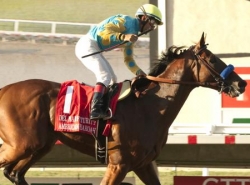How to Analyze Past Performance Fractions

A horse that can break quickly from the gate and put distance between himself and his rivals in the early stages of the race has an inherent advantage in North American racing. With this in mind, the bettor must learn how to accurately interpret the internal clockings contained in all past performances.
Race Fractions Give the Speed of the Leading Horse
In nearly all racing forms, a series of numbers appear next to each corresponding past performance. These numbers illustrate how fast the leader of each race clocked the opening quarter mile, half mile, stretch call and finish. Since six furlongs (a furlong is equal to one eighth of a mile) is the most common of all race distances in North America, let's look at an example of how internal fractions would appear in a horse's past performances for this distance:
Interpreting race fractions in the form
9 Apr16-4OP fst 6f 21 45 58 1:11
In the example above, the fictitious horse in question exits a race run at Oaklawn Park (OP) that was run on April 9, 2016. The race was run over a fast track (fst) and carded at the six furlong distance (6f). In the running of this six furlong sprint, let's assume our horse broke from the gate and maintained the lead the entire way for a gate-to-wire victory. In this case, we know that the horse carved out fractions of 21 seconds for the opening quarter mile, 45 seconds for the half mile clocking, 58 seconds for five furlongs, and finished the six furlong event in one minute and eleven seconds. These internal race fractions provide a basic comparison for determining which horse might get the lead in a future race.
Comparing fractional times
Now let's assume the horse referenced in the example above is coming back at the same distance of six furlongs in his next start. Among the challengers he will face is a horse exiting a similar gate-to-wire victory, but with the fractions below appearing in his past performances:
16 Apr16-6OP fst 6f 21 44 57 1:10
A quick glance shows that the second horse carved out swifter fractions and would be likely to outbreak the horse from the first example. An accepted rule of thumb in horse racing is that the distance of one length is roughly equal to one fifth of a second. Thus, a full second would be five lengths. Rarely are these issues so clear-cut, but this example provides a basis for the beginning horse player trying to make sense of fractional times.
Bet Horse Racing Online!
* REMINDER! - you must be of legal age in your state or province to legally wager on thoroughbred or harness horse racing. Please bet responsibly!
